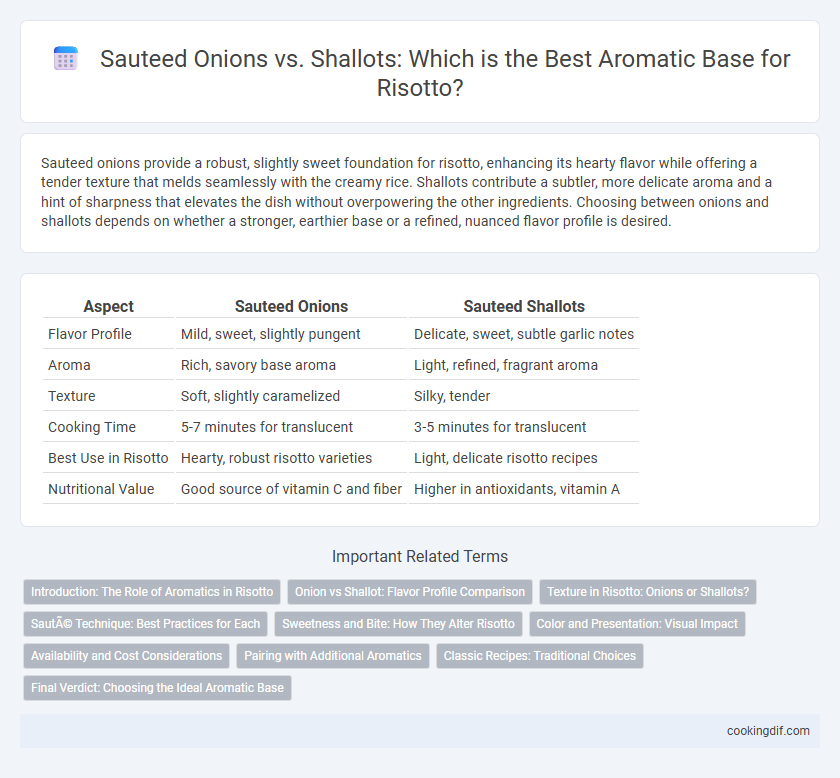Sauteed onions provide a robust, slightly sweet foundation for risotto, enhancing its hearty flavor while offering a tender texture that melds seamlessly with the creamy rice. Shallots contribute a subtler, more delicate aroma and a hint of sharpness that elevates the dish without overpowering the other ingredients. Choosing between onions and shallots depends on whether a stronger, earthier base or a refined, nuanced flavor profile is desired.
Table of Comparison
| Aspect | Sauteed Onions | Sauteed Shallots |
|---|---|---|
| Flavor Profile | Mild, sweet, slightly pungent | Delicate, sweet, subtle garlic notes |
| Aroma | Rich, savory base aroma | Light, refined, fragrant aroma |
| Texture | Soft, slightly caramelized | Silky, tender |
| Cooking Time | 5-7 minutes for translucent | 3-5 minutes for translucent |
| Best Use in Risotto | Hearty, robust risotto varieties | Light, delicate risotto recipes |
| Nutritional Value | Good source of vitamin C and fiber | Higher in antioxidants, vitamin A |
Introduction: The Role of Aromatics in Risotto
Sauteed onions contribute a mild sweetness and a robust foundation to risotto, enhancing its depth of flavor through caramelization. Shallots offer a subtler, more delicate aroma with a hint of garlic, providing a nuanced and refined base that complements the creamy texture of risotto. Selecting between onions and shallots influences the dish's aromatic profile, shaping the overall taste experience.
Onion vs Shallot: Flavor Profile Comparison
Sauteed onions provide a sweet, mellow base with a robust aroma that deepens the risotto's savory character, while shallots offer a subtler, more delicate flavor with mild hints of garlic and anise. Onions tend to deliver a heartier, more pronounced taste, ideal for traditional, rustic risottos, whereas shallots contribute a refined, nuanced complexity suited for lighter, gourmet versions. Choosing between onion and shallot affects the overall aroma and flavor balance, influencing the risotto's depth and sophistication.
Texture in Risotto: Onions or Shallots?
Sauteed shallots create a silkier, more delicate texture in risotto due to their finer layers and higher sugar content, which melt seamlessly into the creamy rice. Onions impart a coarser, slightly firmer bite, adding a subtle texture contrast that complements the dish's richness. Choosing shallots enhances smoothness and subtlety, while onions contribute a heartier mouthfeel, influencing the overall sensory experience of risotto.
Sauté Technique: Best Practices for Each
For a perfectly aromatic base in risotto, sauteing onions requires medium heat and longer cooking to achieve soft, translucent layers that release a mild sweetness, while shallots benefit from lower heat and shorter saute time to preserve their delicate, slightly garlicky flavor without burning. Use a wide, heavy-bottomed pan to ensure even heat distribution and stir frequently to prevent browning and promote uniform caramelization. Incorporating clarified butter or a high-smoke-point oil enhances heat control and prevents burning, maximizing flavor extraction from both onions and shallots.
Sweetness and Bite: How They Alter Risotto
Sauteed onions add a mild sweetness and a gentle bite to risotto, creating a balanced aromatic base that softly enhances the dish's creaminess. Shallots offer a more complex flavor profile, delivering subtle sweetness with a sharper, more pronounced bite that intensifies the risotto's depth. Choosing between onions and shallots influences the overall sweetness and bite, shaping the risotto's final flavor nuance.
Color and Presentation: Visual Impact
Sauteed onions create a golden, translucent base that adds a warm, inviting color to risotto, enhancing its visual appeal by providing a familiar and comforting look. Shallots, with their delicate pale pink or light purple hues, offer a more refined and nuanced color contrast that elevates the presentation with subtle elegance. Choosing shallots can subtly brighten the dish's appearance, contributing to a sophisticated aesthetic that complements gourmet plating.
Availability and Cost Considerations
Sauteed onions are commonly used in risotto for their widespread availability and lower cost, making them a practical choice for many kitchens. Shallots offer a subtler, more complex flavor but tend to be more expensive and less accessible in some regions. Choosing between onions and shallots depends largely on budget constraints and ingredient accessibility without compromising the aromatic foundation of risotto.
Pairing with Additional Aromatics
Sauteed onions provide a robust, slightly sweet base that harmonizes well with garlic, thyme, and rosemary in risotto recipes, enhancing earthy and savory flavors. Shallots offer a more delicate, mildly pungent aroma that pairs effectively with white wine, saffron, and fresh herbs like tarragon or chervil, creating a refined and nuanced flavor profile. Choosing between onions and shallots influences the dish's aromatic complexity and determines which complementary ingredients will best elevate the risotto's overall taste.
Classic Recipes: Traditional Choices
Classic risotto recipes traditionally call for sauteed onions as the aromatic base, contributing a subtle sweetness and depth of flavor to the dish. Shallots, though more delicate and slightly sweeter, are less commonly used in traditional risotto but can provide a nuanced aroma and refined texture. The choice between onions and shallots depends on the desired intensity and authenticity of the risotto's flavor profile.
Final Verdict: Choosing the Ideal Aromatic Base
Sauteed onions provide a robust and slightly sweet foundation that enhances the creamy texture and savory depth of risotto, while shallots offer a more delicate, subtle sweetness with a hint of garlic flavor that elevates the dish's complexity. The ideal aromatic base depends on the desired flavor profile: onions are perfect for traditional, hearty risottos, whereas shallots best suit refined, delicate recipes. Balancing these aromatic options ensures a risotto with a nuanced, layered taste that highlights the ingredients' freshness and richness.
sautéed onions vs shallots for aromatic base Infographic

 cookingdif.com
cookingdif.com